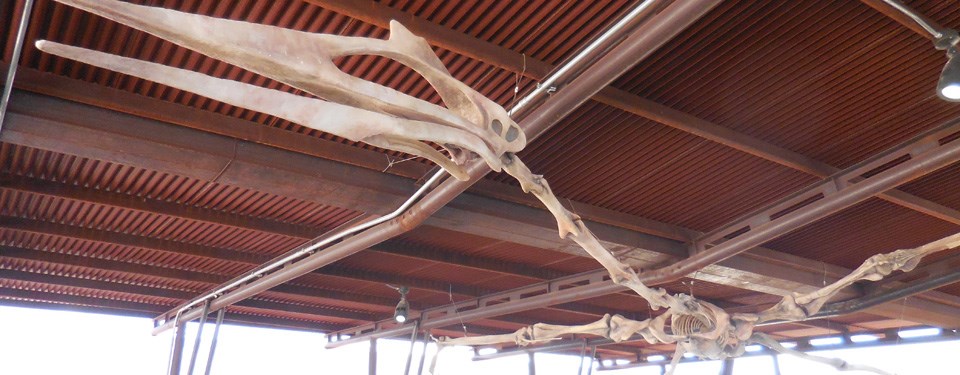
Pterosaur LifewaysThe earliest known pterosaurs lived about 220 million years ago in the Triassic period, and the last ones died about 65 million years ago at the end of the Cretaceous period. They ranged from pigeon-sized with a wingspan of 18 inches to ultralight-airplane-sized Quetzalcoatlus with a wingspan of 36–39 feet. Exceptionally well-preserved fossils have shown that pterosaurs were covered with hair. Pterosaurs were the first vertebrates to adapt to a life of active flight. Only two other groups of vertebrates are active fliers, namely birds and bats. Despite the unavoidable comparison of pterosaurs with birds, it is important to note that they are very different animals that followed different evolutionary pathways. In fact, the early birds existed at the same time as some of the pterosaurs, but birds managed to survive the mass extinctions at the end of the Cretaceous period while pterosaurs did not. Flight tests with models of Quetzalcoatlus suggest that it was primarily a soaring creature controlling its direction by turning its head, flexing the three fingers on the wing's leading edge, and warping the wing tip. These giants, the last of the flying reptiles, were able to climb or dive by changing the wing sweep, but were probably unstable in gusty winds. Pterosaur ExtinctionNot only was Quetzalcoatlus the one of largest of the pterosaurs, it was the last. It was found in the rocks of the latest, uppermost Cretaceous period, just before the beginning of the Tertiary period 65 million years ago. This border between major time periods is known as the Cretaceous-Tertiary boundary, or K-T boundary for short, and marks the great extinction at the end of the Cretaceous. This mass extinction episode wiped out dinosaurs, pterosaurs, marine reptile groups such as plesiosaurs, ichthyosaurs, and mosasaurs, and numerous marine invertebrate species such as ammonites. The K-T boundary marks the end of the Mesozoic era, the Age of Reptiles, and denotes the beginning of the Cenozoic era, the Age of Mammals. The K-T boundary has received intense scientific study in recent years as researchers try to understand the changes between the time periods. Big Bend's rocks are important to this study because the K-T boundary is well preserved, is clearly exposed, and is one of the southernmost exposures of terrestrial sedimentary rocks of that time period. On a geologic scale, Big Bend is relatively close to the well-publicized Yucatan meteor impact point, which has recently gained favor as an explanation for the abrupt changes seen at the K-T boundary. It is important to understand that even if the Yucatan meteor is shown to be the coup de grace that finished off many Mesozoic species, it is only a small part of the story. Indeed, the fossil record clearly shows that these animals were gradually declining in diversity, with numerous species going extinct during the Upper Cretaceous, over millions of years. During this time the world's climate was changing as shallow seas were draining, mountains were being built, temperatures were cooling, and perhaps wind speeds were increasing. Although a meteor may have finished things with a bang, the real culprit in most of the Cretaceous extinctions was long-term global climate change. Discovery of the Fossil:Quetzalcoatlus northropi In 1971, Douglas A. Lawson, a student at the University of Texas in Austin, was performing geological field work in Big Bend National Park for his master’s thesis when he discovered a fossil bone eroding out of an arroyo bank. His professor, Dr. Wann Langston Jr., determined that this long, hollow, very thin-walled bone could only be from a pterosaur wing. Subsequent excavations recovered more wing bones, but unfortunately the wing must have detached from the body before being buried and fossilized, because no body bones could be found. Lawson named his discovery Quetzalcoatlus after the Mexican deity Quetzalcoatl, who was worshipped by the Aztecs in the form of a feathered snake. Dr. Langston continued to search for and study Big Bend fossils and eventually found other specimens of Quetzalcoatlus in another part of the park. Although these specimens were smaller than the original, they were more complete and had a very impressive wingspan of at least 18 feet. Comparison of these complete specimens with the huge bones of the original Quetzalcoatlus made it possible to calculate the body size of Lawson’s specimen. This enormous pterosaur had an estimated wingspan of 36–39 feet, making it the largest known flying creature of all time. It is not yet clear whether the smaller specimens were young individuals of the large species, or whether they represent a distinct, smaller species of Quetzalcoatlus. The World's Largest FlierGet up close and personal with this amazing creature. At Big Bend's new Fossil Discovery Exhibit, a life-size replica of this enormous pterosaur "flies" above you. The 18-foot long specimen was discovered here in Big Bend National Park and represents the second largest known flying creature ever to have existed. Its name is Quetzalcoatlus northropi. Pterosaur Facts:
One of A Kind FossilsFossil Discovery Exhibit |
Last updated: April 28, 2020
